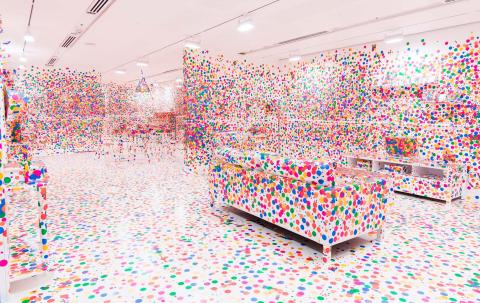Kusama’s Obliteration room
By Reuben Keehan
‘We Can Make Another Future’ September 2014
The obliteration room is an interactive work initially developed by Yayoi Kusama in collaboration with the Queensland Art Gallery as a children’s project for ‘APT2002: Asia Pacific Triennial of Contemporary Art’. Reworked and enlarged in 2011 for Kusama’s ‘Look Now, See Forever’ exhibition at the Gallery of Modern Art, the work became a social media phenomenon when progressive images of the installation were uploaded to a popular visual culture blog.1
The work consists of a domestic environment recreated in the gallery space, complete with locally sourced furniture and ornamentation, all of which are painted completely white. While this may suggest an everyday topography drained of all colour and specificity, it also functions as a blank canvas to be invigorated — or, in Kusama’s vocabulary, ‘obliterated’ — through the application to every available surface of brightly coloured stickers in the shape of dots. The choice of a domestic environment with specifically local characteristics is intended to create an air of familiarity that makes participants, especially children, comfortable enough to engage with the work with little or no prompting.
Dots first emerged in Kusama’s work in the early 1960s as the structural inverse of the ‘Infinity net’ paintings that preoccupied her after 1958 — the dots were to be found in the negative space left between the loops of painterly netting. During this period, dots began to cover the surfaces of her sculptures and installations, which, for Kusama, recalled the hallucinations she had suffered as a child, in which her surroundings were entirely covered with repeating patterns. Later in the decade, dots had developed into an artistic strategy that the artist described as ‘self-obliteration’. A prominent feature of her ‘happenings’ and performances of the period, and usually daubed onto the bodies of participants, dots symbolically neutralised the ego, which Kusama blamed for the horror and destruction resulting from warfare.
Kusama’s dots have proliferated as her installations have grown in scale and ambition, and she continues to frame the dots as traces of her own childhood trauma. The past decade in fact has seen direct representations in the artist’s work of an idealised, ‘lost’ childhood. The exuberance of children buzzing around The obliteration room, stickers accumulating on its clinical surfaces, bears a striking resemblance to this imagined childhood from Kusama’s later work. Indeed, The obliteration room functions by mobilising the desires of children to transgress the ‘look, but don’t touch’ restriction of conventional museum culture by associating this sensibility with that of parental restrictions in the family home.
The white room is gradually covered with stickers over the course of the exhibition, the space changing measurably with the passage of time as the dots accumulate with the help of thousands of collaborators. As with many of Yayoi Kusama’s installations, the work is disarmingly simple in its elemental composition; however, it brilliantly exploits the framework of its presentation. The obliteration room underlines the broad and substantial appeal of contemporary art and its confusion of previously distinct categories of spectatorship, participation and authorship. In many ways, it dramatises the shift in the practice of museums that has seen the white cube become a more participatory and experiential space. That this has taken place alongside the expansion of the participatory and experiential space of the internet is underlined by the work’s amenity to social media, where liking, pinning, sharing or re-blogging function as virtual extensions of picking up a dot and pressing it to the wall.
Endnote
- Christopher Jobson, ‘This is what happens when you give thousands of stickers to thousands of kids’, This is Colossal, viewed 7 April 2014.
Connected objects
Metadata, copyright and sharing information
About this story
- Subject
